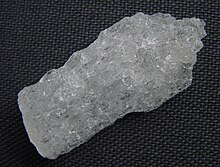| Kalinite | |
|---|---|
 Kalinite from the Virgin Valley District, Nevada, USA. Specimen size 5.4 cm | |
| General | |
| Category | Sulfate minerals |
| Formula (repeating unit) | KAl(SO4)2·11H2O |
| IMA symbol | Kli[1] |
| Strunz classification | 7.CC.15 |
| Dana classification | 29.5.4.2 |
| Crystal system | Monoclinic |
| Crystal class | Prismatic (2/m) (same H-M symbol) |
| Space group | C2/c |
| Unit cell | a = 19.92(16), b = 9.27(3) c = 8.304(13) Å β = 98.79(19)°; Z = 4 |
| Identification | |
| Formula mass | 456.37 g/mol |
| Color | White to pale blue |
| Crystal habit | Fibrous |
| Fracture | Conchoidal |
| Mohs scale hardness | 2 to 2.5 |
| Luster | Vitreous |
| Streak | White |
| Diaphaneity | Transparent |
| Specific gravity | 1.75 (observed) 2.0 (calculated) |
| Optical properties | Biaxial (−) |
| Refractive index | nα = 1.429 to 1.430, nβ = 1.452, nγ = 1.456 to 1.458 |
| Birefringence | None |
| 2V angle | 52° (measured), 82° (calculated) |
| Solubility | Soluble in water |
| Other characteristics | Not fluorescent, barely detectable radioactivity |
| References | [2][3][4][5] |
Kalinite is a mineral composed of hydrated potassium aluminium sulfate (a type of alum). It is a fibrous monoclinic alum, distinct from isometric potassium alum,[6] named in 1868. Its name comes from kalium (derived from Arabic: القَلْيَه al-qalyah "plant ashes", which is the Latin name for potassium, hence its chemical symbol, "K".
A proposal to remove recognition of kalinite as a mineral species was submitted to the International Mineralogical Association;[5] however, kalinite is still on the list of approved minerals.[7] Many older samples, however, have been found to be potassium alum.[3]
- ^ Warr, L.N. (2021). "IMA–CNMNC approved mineral symbols". Mineralogical Magazine. 85 (3): 291–320. Bibcode:2021MinM...85..291W. doi:10.1180/mgm.2021.43. S2CID 235729616.
- ^ Gaines et al (1997) Dana’s New Mineralogy, Wiley
- ^ a b Kalinite data in the Handbook of Mineralogy
- ^ Kalinite on Webmin
- ^ a b Kalinite on Mindat
- ^ American Mineralogist (1923) 8:15
- ^ "IMA Mineral List with Database of Mineral Properties".